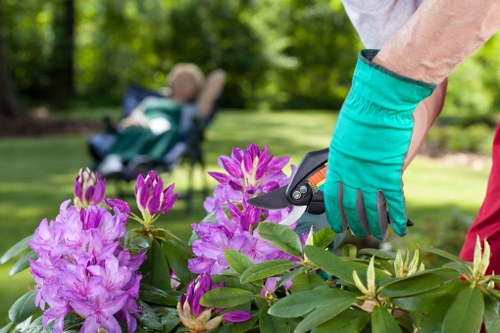Garden Fence Installation in Garden Landscapes

Introduction to Garden Fence Installation
A well-installed garden fence not only enhances the aesthetic appeal of your garden landscape but also provides essential functionality such as privacy, security, and boundary definition. Whether you have a sprawling backyard or a compact urban garden, choosing the right fence can make a significant difference in the overall look and feel of your outdoor space.
Garden fence installation is a crucial aspect of landscape design that requires careful planning and execution. It involves selecting materials, determining the fence height and style, and ensuring that the installation process is carried out efficiently to withstand weather conditions and regular wear and tear.
In this article, we will explore the various aspects of garden fence installation, including types of fences, materials, design considerations, and practical tips to help you make an informed decision for your garden landscape.

Types of Garden Fences
Wood Fences
Wooden fences are a popular choice for garden landscapes due to their natural beauty and versatility. They can be customized in various styles, such as picket, lattice, or privacy fences, to match your garden’s aesthetic.
Pros of Wood Fences:
- Natural appearance that blends well with garden settings
- Can be painted or stained in different colors
- Offers good privacy and security
Cons of Wood Fences:
- Requires regular maintenance to prevent rot and decay
- Vulnerable to pests like termites
- Higher upkeep costs over time
Metal Fences
Metal fences, including aluminum, wrought iron, and steel, are known for their durability and strength. They are ideal for gardens that require a secure boundary without compromising on style.
Pros of Metal Fences:
- Long-lasting and low maintenance
- Resistant to weather elements
- Offers a range of designs from classic to contemporary
Cons of Metal Fences:
- Can be prone to rust if not properly treated
- Typically more expensive than wood
- Less privacy compared to solid wood fences

Choosing the Right Material
Consider Durability
When selecting a fence material, it’s essential to consider its durability against the local climate and environmental conditions. Materials like vinyl and metal tend to offer superior resistance to weathering compared to wood.
Maintenance Requirements
Different materials require varying levels of maintenance. For instance, wooden fences may need regular staining or painting, while metal fences might only need occasional cleaning to maintain their appearance.
Budget Constraints
Your budget will significantly influence the type of fence you can afford. While high-quality materials like wrought iron or premium wood may have higher upfront costs, they can offer better longevity and return on investment.
Environmental Impact
Consider the environmental footprint of the materials you choose. Eco-friendly options like sustainably sourced wood or recycled metal can contribute to a greener garden landscape.

Design Considerations
Height and Scale
The height of your garden fence should complement the size of your garden and the surrounding structures. Taller fences provide more privacy, while shorter ones can enhance openness and visibility.
Style and Aesthetics
Your fence should harmonize with the overall style of your garden landscape. Whether you prefer a rustic, modern, or traditional look, there are fence designs that can enhance your garden’s aesthetic appeal.
Functionality
Consider the primary purpose of your fence. If security is a concern, a sturdy metal fence might be appropriate. For decorative purposes, a picket or lattice fence could be more suitable.
Local Regulations
Before installation, check local zoning laws and regulations regarding fence height, materials, and placement to ensure compliance and avoid potential fines.

Installation Process
Preparing the Site
Proper site preparation is crucial for a successful fence installation. This includes clearing the area of obstacles, marking the fence line, and ensuring the ground is level and stable.
Measuring and Marking
Accurate measurements and markings ensure that the fence is installed straight and evenly. Use stakes and string to outline the fence perimeter before starting the installation.
Setting Fence Posts
Fence posts provide the structural support for your fence. Digging appropriate post holes, setting the posts in concrete, and ensuring they are level is essential for stability and longevity.
Installing Fence Panels
Once the posts are in place, attach the fence panels or materials securely. Ensure that each panel is aligned correctly and that there are no gaps or inconsistencies.
Finishing Touches
After the main structure is installed, add any finishing touches such as gates, decorative elements, or additional reinforcement to enhance the fence’s appearance and functionality.
Maintenance Tips
Regular maintenance extends the life of your garden fence and keeps it looking pristine. Here are some essential maintenance tips:
- Inspect Regularly: Check for any signs of damage, rot, or rust and address issues promptly.
- Clean Periodically: Remove dirt, debris, and algae to maintain the fence’s appearance.
- Repaint or Stain: Apply fresh coats of paint or stain to protect the material and enhance its look.
- Repair Damage: Fix any broken boards, loose nails, or bent metal sections to maintain structural integrity.
By following these maintenance practices, you can ensure that your garden fence remains a beautiful and functional part of your landscape for years to come.
Protect Against Weather
Weather conditions can take a toll on your fence. Applying weather-resistant treatments and choosing materials that withstand local climate conditions can help protect your investment.
Vegetation Control
Keep plants and vines from growing on your fence, as excessive vegetation can cause decay and damage over time. Regular trimming and pruning can help maintain the fence’s condition.
Benefits of Professional Installation
While DIY fence installation can save money upfront, hiring professionals offers several advantages:
- Expertise: Professionals have the knowledge and experience to handle various materials and complex installations efficiently.
- Quality Assurance: Ensures that the fence is installed correctly and meets all safety and aesthetic standards.
- Time-Saving: Reduces the time and effort required, allowing you to focus on other aspects of your garden project.
- Warranty and Support: Professional installers often provide warranties and ongoing support for their work.
Choosing professional garden fence installation ensures a high-quality outcome that enhances your garden landscape's beauty and functionality.
Cost Efficiency
While the initial cost may be higher, professional installation can prevent costly mistakes and repairs in the future, offering better long-term value.
Customized Solutions
Professionals can provide tailored solutions that meet your specific needs and preferences, ensuring your fence perfectly complements your garden landscape.
Conclusion
Garden fence installation is a vital component of landscape design that offers both aesthetic and practical benefits. By carefully selecting the right materials, design, and installation method, you can create a stunning and functional boundary that enhances your garden's beauty and utility.
Whether you opt for the natural charm of wood, the strength of metal, or the versatility of other materials, a well-installed fence can transform your garden landscape into a more inviting and secure space.
Contact us today to discuss your garden fence installation needs and take the first step towards transforming your outdoor space.